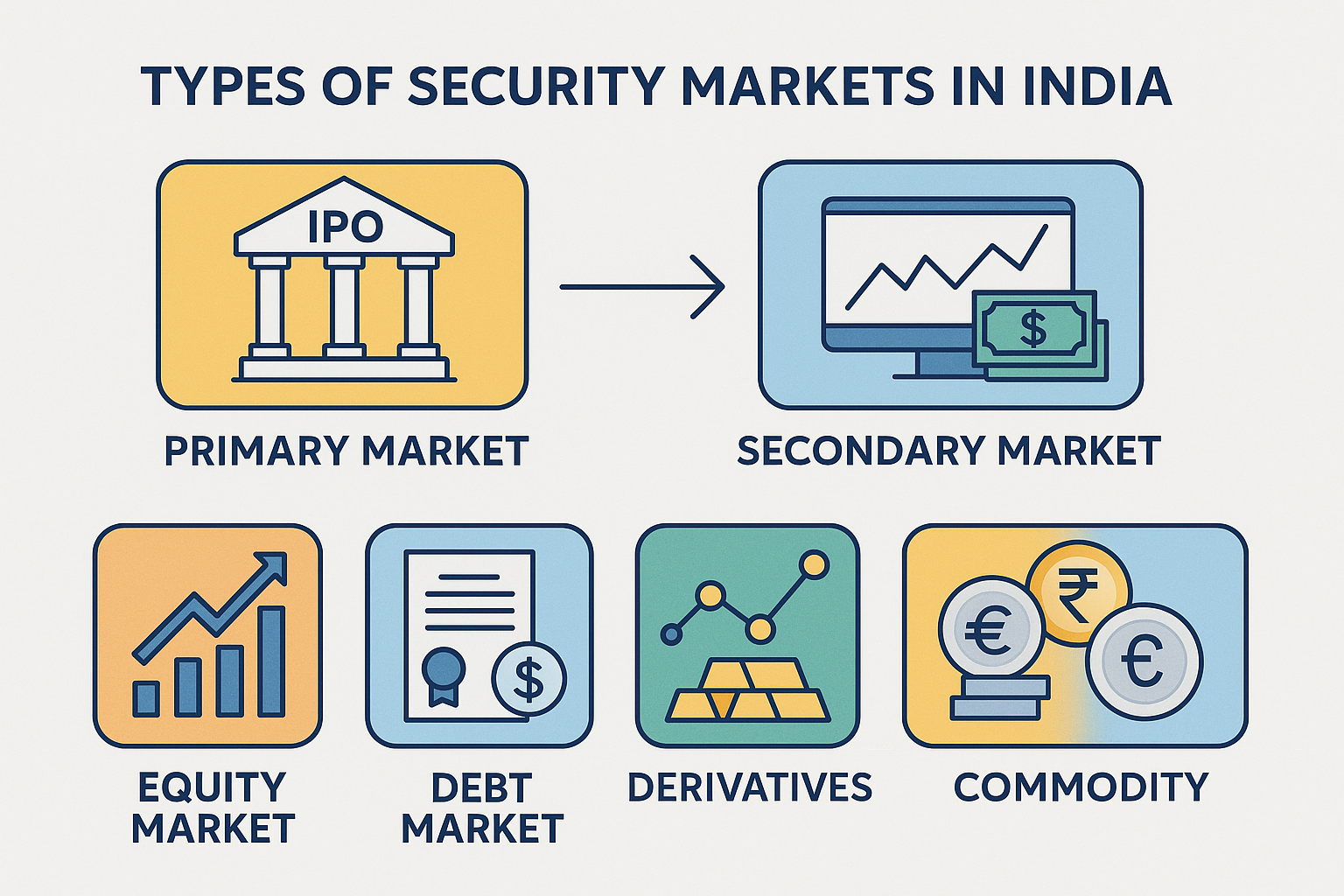Understanding Security Markets in India
Primary, Secondary, Equity & More: Understanding Security Markets in India

If you’ve ever wondered where and how people in India buy shares, trade gold, or invest in government bonds, then you’re thinking about the securities market.
Whether you’re a first-time investor or simply looking to brush up on your financial knowledge, understanding the different types of security markets in India is a great place to start. These markets are where all the action happens – from IPOs to day trading, and everything in between.
In this blog, we’ll walk you through the main types of security markets in India with simple explanations and real-life examples. Let’s dive in!
1. Primary Market – Where It All Begins
The primary market, also known as the new issue market, is where companies go to raise money for the first time. This is where new securities like shares and bonds are created and sold directly to investors.
📌 Example:
Remember when LIC (Life Insurance Corporation of India) launched its IPO in 2022? That was a classic primary market move. Investors got a chance to buy LIC shares directly before they were available on stock exchanges.
Key Features:
Companies raise fresh capital
Investors buy directly from the issuer
Includes IPOs, FPOs, rights issues, and private placements
2. Secondary Market – Where the Trading Happens
Once a company’s shares are listed, they start trading in the secondary market – also known as the stock market. This is where investors buy and sell shares from each other, not from the company.
📌 Example:
Buying or selling Reliance, Infosys, or Tata Motors shares on the NSE or BSE? That’s the secondary market in action.
Why It Matters:
Provides liquidity to investors
Helps in price discovery
Keeps the market active and transparent
3. Equity Market – Owning a Piece of a Company
The equity market is a part of the broader security market where investors buy shares to become partial owners of companies. It’s ideal for those who want to grow their wealth over the long term.
📌 Example:
Buying stocks of HDFC Bank or Zomato gives you a small ownership in the company.
Benefits of Equity Investing:
Potential for high returns
Dividend income
Voting rights as a shareholder
4. Debt Market – For Safe and Stable Returns
If you’re someone who prefers steady income over high risk, the debt market could be your best friend. It’s where investors buy instruments like bonds and debentures that pay fixed interest.
📌 Example:
Investing in RBI Bonds or NTPC Debentures means you’re lending money to them in exchange for interest.
Common Debt Instruments:
Government Bonds (G-Secs)
Corporate Bonds
Treasury Bills
Commercial Papers
5. Derivatives Market – For the Risk-Takers and Strategists
The derivatives market is a more advanced segment where investors trade contracts based on the value of underlying assets like stocks, indices, or commodities.
📌 Example:
If you’re trading Nifty Futures or Bank Nifty Options, you’re in the derivatives market.
Used For:
Hedging risks
Speculating on price movements
Leveraging investments
6. Commodity Market – Trading Gold, Oil & More
Want to invest in gold, silver, crude oil, or even agricultural products? The commodity market is where it all happens, mostly through exchanges like the MCX (Multi Commodity Exchange).
📌 Example:
Trading Gold Futures on MCX or investing in Crude Oil Contracts.
Top Traded Commodities:
Gold & Silver
Crude Oil & Natural Gas
Cotton, Wheat, and Spices
7. Currency Market – Where Global Meets Local
he currency market (or forex market) allows you to trade in currency pairs like USD/INR or EUR/INR. It’s a crucial market for importers, exporters, and investors dealing with foreign exchange risks.
📌 Example:
Trading in currency futures on the NSE’s Currency Derivatives platform is part of the currency market.
🧠 Quick Summary:
| Market Type | Main Purpose | Example |
|---|---|---|
| Primary Market | Raise capital through new issues | LIC IPO in 2022 |
| Secondary Market | Trading of existing securities | Buying Reliance shares on NSE |
| Equity Market | Ownership in companies | Investing in HDFC Bank |
| Debt Market | Fixed income from bonds | Buying RBI Bonds |
| Derivatives Market | Hedging/speculation on future prices | Nifty Futures |
| Commodity Market | Trading physical goods via contracts | Gold Futures on MCX |
| Currency Market | Buying/selling foreign currencies | USD/INR pair trading |
🏁 Final Thoughts
India’s security market is full of opportunities for all types of investors – whether you’re risk-averse, risk-tolerant, or somewhere in between. By understanding how each market works, you can diversify your portfolio and make smarter financial decisions.
At Marfo.in, we help simplify complex financial products and make investing easier for you. Whether you’re interested in stocks, mutual funds, insurance, or more – we’ve got you covered.

